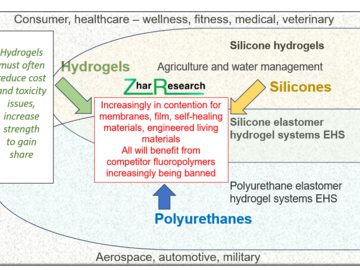New Hydrogel Procedures Transforming Medicine
Three-dimensional hydrogel-based organ-like cultures can be applied to study development, regeneration, and disease in vitro. Remarkable work is proceeding to help the blind to see, the deaf to hear and the paralysed to move. The key is new procedures for repair, regrowth and fabrication using sophisticated new hydrogels.
Hydrogel-in-hydrogel bioprinting
Previously, the control of engineered hydrogel composition, mechanical properties and geometrical constraints tended to be restricted to the initial time of fabrication. Modulation of hydrogel characteristics over time and according to culture evolution was often not possible but new work at the University of Padua in Italy addresses this. See “Hydrogel-in-hydrogel live bioprinting for guidance and control of organoids and organotypic cultures”. Nature Communications volume 14, Article number: 3128 (2023).
The researchers see a broad range of potential applications such as cancer treatment and regeneration of liver and lungs. The hydrogel-in-hydrogel structures fabricated with this method require diffusion of the photosensitive polymer within the pre-existing 3D biological construct. This is why the approach proposed has broad applicability, allowing temporal and spatial design and guidance of 3D structures for targeting specific time windows and/or cell types in 3D cultures.
The researchers have overcome the limitations by developing a hydrogel-in-hydrogel live bioprinting approach that enables the dynamic fabrication of instructive hydrogel elements within pre-existing hydrogel-based organ-like cultures. They achieve this by crosslinking photosensitive hydrogels via two-photon absorption at any time during culture. It turns out that instructive hydrogels guide neural axon directionality in growing organotypic spinal cords, and that hydrogel geometry and mechanical properties control differential cell migration in developing cancer organoids. In addition, the researchers find that hydrogel constraints promote cell polarity in liver organoids, guide small intestinal organoid morphogenesis and control lung tip bifurcation according to the hydrogel composition and shape.
Elastomer hydrogel systems EHS and engineered living materials ELM
The bigger picture is addressed in the new Zhar Research report, “Hydrogels: Future Technologies and Markets 2024-2044”. This is obtainable from www.zharresearch.com and www.giiresearch.com. It covers two new branches of materials science - elastomer hydrogel systems EHS and engineered living materials ELM and many other aspects. There is analysis of the needs and solutions for cooling, self-healing, tissue engineering, bone regeneration, skin regeneration, restored vision, overcoming paralysis, smart prosthetics and injected hydrogels. Closely allied topics also covered include new hydrogels for soft robotics, water capture, water purification, water delivery, drug delivery, anti-fouling, medical and environmental applications. These aspects are linked to coverage of hydrogels in agriculture, buildings, construction, flexible electronics, batteries and solar panels.
For those specifically interested in self-healing materials in healthcare, there is the new Zhar Research report, “Self-Healing Healthcare Material Markets, Technology: 2024-2044” and there is a free introductory webinar on www.zharresearch.com called, “Self-Healing Materials: Big Markets 2024-2044” on www.zharresearch.com.
Hydrogel virtuosity with challenges
Dr Peter Harrop, CEO of Zhar Research observes,
“Hydrogels are the chemical family closest to human tissue and most likely to be both self-healing and biocompatible. Their virtuosity is seen from shape-memory injectables to medical cooling and contact lenses.”
He adds,
“Researchers are making excellent progress in tackling some remaining limitations of hydrogels. They include the fact that although popular versions are non-toxic some are toxigen intermediaries: they have toxic precursors and breakdown products that cannot be removed from soil. Some are expensive to make or are not sufficiently long-lived for certain required applications. Most are mechanically weak, particularly when allowed to dehydrate, and this is not always a good thing. Partly because of this, hydrogels are increasingly competing with or combined with silicones and polyurethanes. Both of those are currently larger value markets than the market for hydrogels. ”
Press release distributed by Pressat on behalf of Zhar Research , on Friday 17 November, 2023. For more information subscribe and follow https://pressat.co.uk/
Healthcare Medical Cancer Treatment Hydrogels Self-Healing Materials Future Technology ELM EHS Medicine Implants Business & Finance Consumer Technology Education & Human Resources Health Manufacturing, Engineering & Energy Medical & Pharmaceutical Opinion Article
Published By

anastasiams@zharresearch.com
https://www.zharresearch.com/
Dr Peter Harrop
peterharrop@zharresearch.com
Visit Newsroom
You just read:
New Hydrogel Procedures Transforming Medicine
News from this source:



